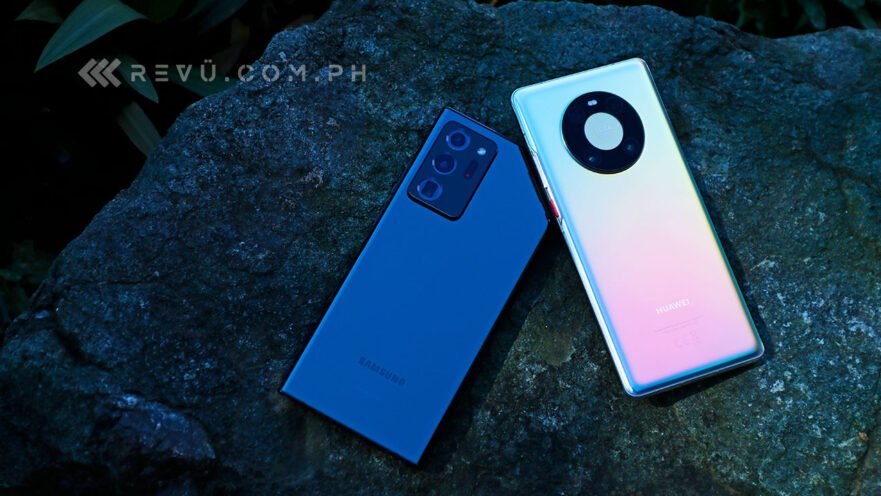Though no one can predict the future — and certainly not anything that could happen in 2020 — Huawei and Samsung are probably done releasing premium smartphones for this year. Back in August, Samsung introduced the Note 20 lineup, including the Samsung Galaxy Note 20 Ultra, which is basically the non-5G version of the Galaxy Note 20 Ultra 5G with less RAM. The Huawei Mate40 Pro was announced a couple of months later.
So, here we are with the anticipated battle to end the year, a face-off pitting two cutting-edge devices against one another to determine which one deserves a seat at the top table.
There’s the Mate40 Pro in one corner, a curvy camera powerhouse boasting a gorgeous, generously sized OLED screen with 90Hz refresh and the most powerful and most advanced chipset in an Android phone. In the other, the Samsung Galaxy Note 20 Ultra, which looks formidable with its triple-camera setup and embedded S Pen stylus. So, which flagship is better all around? Read on for our verdict.
Hardware
As you’d expect, both the Huawei Mate40 Pro and Samsung Galaxy Note 20 Ultra feature flagship designs and top-grade build quality that’s befitting the price point. They have big, curved OLED panels on the front, the Huawei being decidedly curvier than the Samsung, and rounded edges at the back as well. They also share an aluminum frame with discrete antenna bands and tactile side buttons that feel good to press, although it’s worth mentioning that the Mate40 Pro has a red power/wake button, making it easier to locate in the dark.
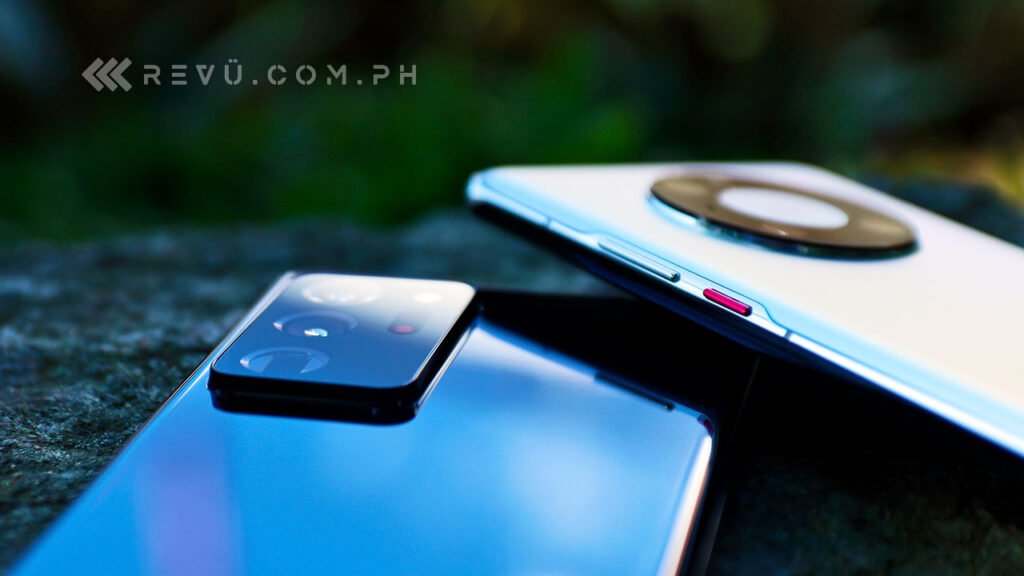
The Samsung Galaxy Note 20 Ultra and Huawei Mate40 Pro feature flagship designs and top-grade build quality that’s befitting the price point
Another obvious difference is that Samsung opted for boxy, angular design, whereas Huawei decided on something that falls in line with its P40 series, with the Mate40 Pro’s internals housed in a curvier chassis. This aesthetic extends to the main camera, which has a large circular cutout that Huawei refers to as “Space Ring Design” in the upper-middle portion of the rear panel. Interestingly, the same can be said about the Galaxy Note 20 Ultra, with a rectangular camera module bulging from its back.
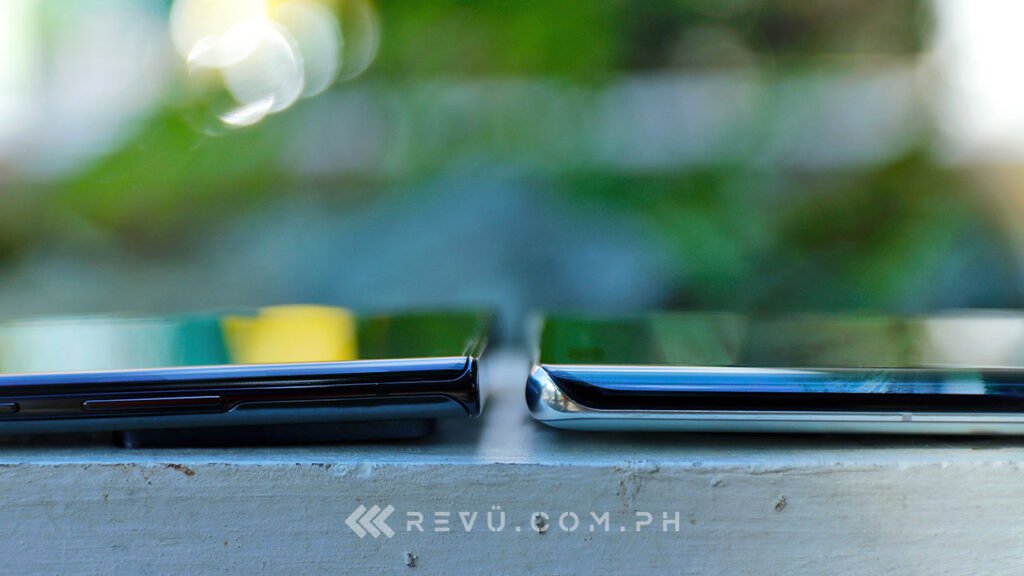
The Galaxy Note 20 Ultra’s rectangular camera module bulges from the smartphone’s back
The back of the Mate40 Pro uses matte glass, which is not only more visually appealing, but also pleasant to hold and keeps fingerprints and smudges from cluttering up the handset’s look. The Galaxy Note 20 Ultra has a glossier exterior that is harder to keep pristine.
Size-wise, the Huawei is a little shorter and narrower than the Galaxy Note 20 Ultra. This makes the Mate40 Pro easier to hold and operate with one hand. And you probably won’t have too much trouble sliding it into your jeans pocket. It can even be tucked into your purse without causing a significant bulge. Both devices feel substantial, so one-handed use will likely be cumbersome for most people.
If you ask us, we prefer the Huawei Mate40 Pro’s hardware, especially its Mystic Silver version, which dazzles with a wide range of colors when viewed at different angles and reacts to light better than any color variant of the Samsung flagship.
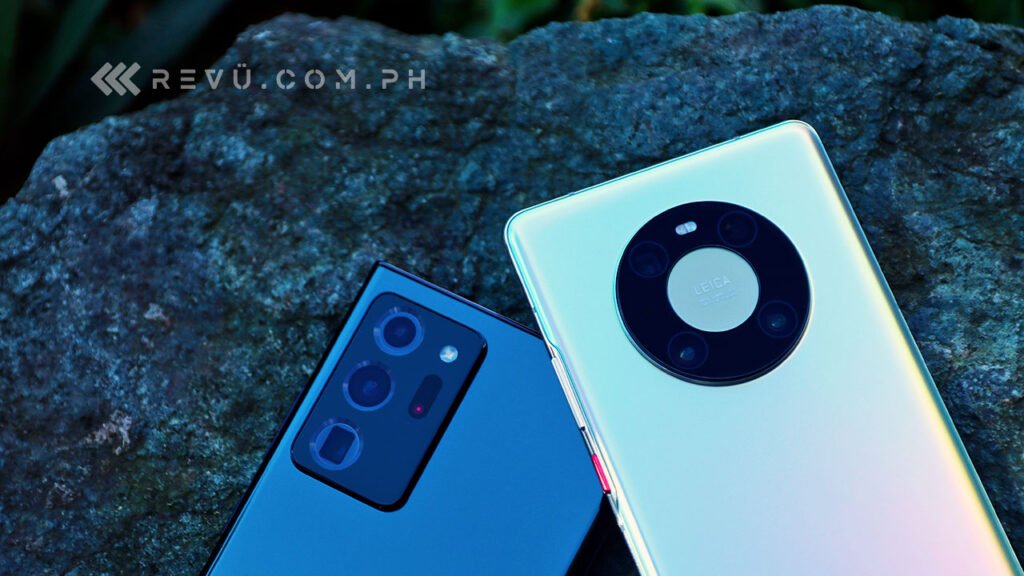
We prefer the Huawei Mate40 Pro’s hardware, especially its Mystic Silver version
Unsurprisingly, neither phone comes with a headphone jack. It’s a common omission in the premium smartphone space. Both companies offer a diverse and high-quality selection of wireless earbuds, so that shouldn’t be a problem for those who can afford a flagship. The Huawei Mate40 Pro includes an IR blaster for things like TV control. There’s still no IR blaster on Samsung’s recently released flagships, including the Galaxy Note 20 Ultra. It’s a curious omission for one of the biggest names in the home-entertainment and appliances industry.
Both phones offer IP68 certification for water and dust resistance; they will survive splashes of water, but probably not being submerged in water for a good amount of time. That said, swimming with either handset is a no-no, definitely.
There are hardware-based security features here that you won’t find at lower price brackets. The Samsung has Find My Mobile and Knox end-to-end security that protects your data in real time, while Huawei offers a bunch of functions to help you secure your files and information, such as Find Device (which does what its name implies and is similar to Find My Mobile on the Galaxy Note 20 Ultra), Password Vault, App Lock, Safe, and App Twin, which lets you log into an app with two different accounts simultaneously.
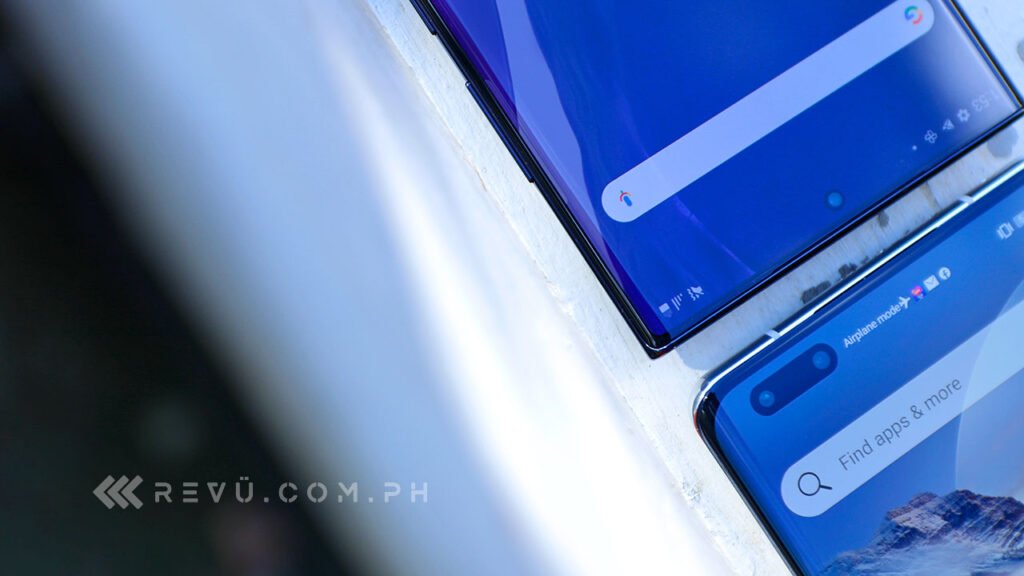
The Huawei Mate40 Pro’s front sensors (bottom unit) make unlocking even with a face mask fast. The phone even goes as far as incorporating its face-unlock tech into its always-on lock screen
We believe the Mate40 Pro’s most useful security feature, though, is its front-facing camera system with face unlock baked in. The sensors on the front make unlocking even with a face mask fast. It makes running errands easier, as you won’t have to rely on the under-screen fingerprint scanner all the time. The Note 20 Ultra also gets face unlock, but it’s not quite as fast, or nearly as reliable, especially in dim lighting.
The Mate40 Pro even goes as far as incorporating its face-unlock tech into its always-on lock screen, allowing you to simply glance at the display to see the lock screen and check for notifications and other important system information. We’ve only seen this feature on Huawei’s newest Mate, and it’s something we’d like to see the company continue to implement and improve in the future. We hope other smartphone makers do, too.
Screen
The Huawei Mate40 Pro has a smaller, slightly less dense OLED screen, coming in at 6.76 inches across and packing 2,772 x 1,344 pixels. The aspect ratio is 18.5:9, which is pretty tall, and the refresh rate maxes out at 90Hz. Huawei says it could have easily opted for a faster display, but doing so would compromise the phone’s battery life. And we agree, based on what we’ve seen from the company’s latest Mate, as well as other flagships with 120Hz or 144Hz refresh.
Unfortunately, a fast OLED doesn’t come without a cost. Between having the fastest refresh in the industry and longer battery life, we’d pick the latter in a heartbeat. Plus, the display of the Mate40 Pro can run at 90Hz while supporting its highest native resolution, unlike the Galaxy Note 20 Ultra.
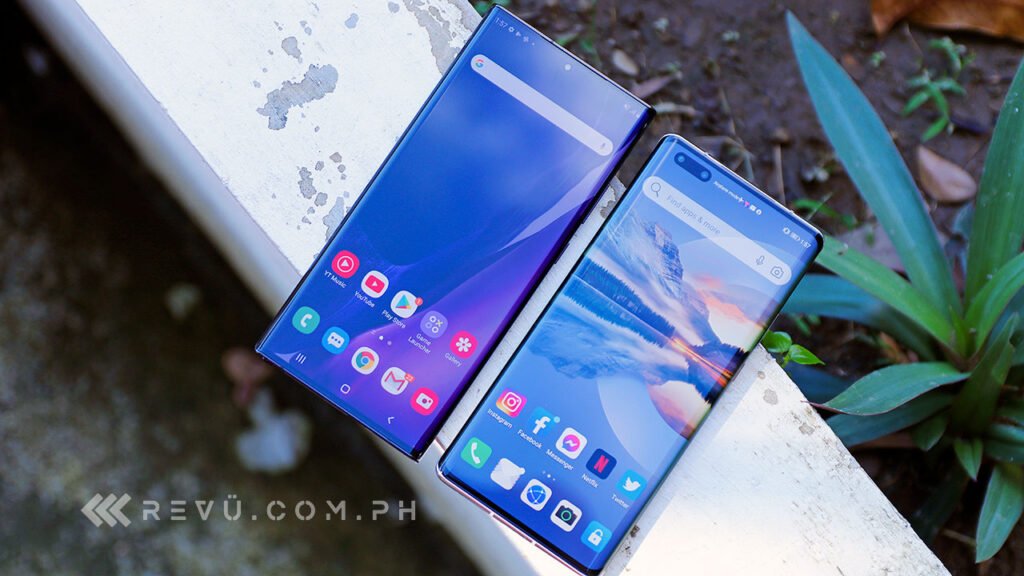
The Huawei Mate40 Pro (right) has a smaller, slightly less dense OLED screen
The Samsung sports a 6.9-inch Dynamic AMOLED with 3,088 x 1,440 pixels at an odd aspect ratio of 19.3:9. The pixel density works out to 496 dots per inch, which is more than what the Mate40 Pro delivers. The Galaxy Note 20 Ultra has a touch-sampling rate of 240Hz, same as the Huawei device.
The highest supported refresh rate here is 120Hz, or double what the typical smartphone offers. Unfortunately, the 1440p resolution also locks the refresh to 60Hz. To get the screen running faster and more fluidly, you need to downgrade it to 1080p. It’s a huge compromise that anyone looking at the Samsung Galaxy Note 20 Ultra should know. And it’s not like having both a 2K resolution and a 120Hz refresh is completely unheard of either.
So, while the screen on the Mate40 Pro isn’t faster than what the Galaxy Note 20 Ultra has, it can run higher than 60Hz and produce a sharper image at the same time. This alone should give the Huawei a leg up on the competition, especially since the 1440p resolution of the current-gen Note isn’t noticeably better than the Mate40 Pro’s 1344p even when you hold both devices close to your face.
To get the Galaxy Note 20 Ultra’s screen running faster and more fluidly, you need to downgrade it to 1080p. The Mate40 Pro’s isn’t faster, but it can run higher than 60Hz and produce a sharper image at the same time
Picture quality is good; the viewing experience is immersive, thanks to the curvature on both panels. Netflix and YouTube look punchy and deep. Both screens also pack more than enough pixels, and brightness isn’t a problem outdoors or in a brightly lit room. They support always-on functionality as well, although the Mate40 Pro brings many options, with free and paid styles, in addition to customizable templates.
Both devices support stylus input and come with software and system shortcuts that make it easy for users to jot down notes on the go and collaborate on documents and presentations. However, if you plan on picking up the Huawei Mate40 Pro, you need to purchase a compatible M-Pen stylus. The recently announced M-Pen 2 works better than anything on the market, but the first M-Pen will get the job done, too.
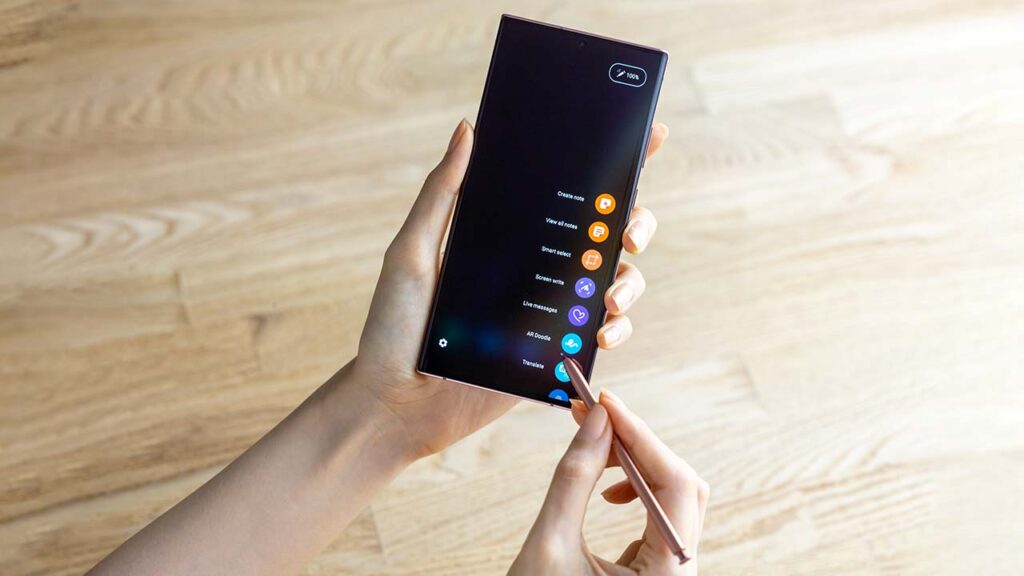
The Samsung Galaxy Note 20 Ultra, owing to years of integration and innovation, has better stylus support
The Samsung Galaxy Note 20 Ultra, owing to years of integration and innovation, has better stylus support than we saw on the Mate40 Pro. The squared-off frame of the Note also allows the pen to slide straight up into the left side of the handset.
Camera
Talking about imaging specs and performance, the Huawei Mate40 Pro has a new Leica-tuned camera system on the back, one that earned the phone the highest rating ever in DxOMark’s phone-camera charts. Meanwhile, the Samsung Galaxy Note 20 Ultra boasts a 108-megapixel camera, alongside 12-megapixel sensors for ultra wide and telephoto.
We’re looking at a bunch of cameras here, so here’s a guide to give you a good idea of how these smartphones stack up against each other:
- Huawei Mate40 Pro
- Rear cameras
- 50-megapixel Super Sensing Wide camera with f/1.9 aperture lens, 23mm focal length, RYYB sensor, OIS (main)
- 20-megapixel Ultra Wide Cine camera with f/1.8 lens, 18mm focal length
- 12-megapixel Periscope Telephoto camera with f/3.4 periscope lens, 125mm focal length, 5x optical zoom, 50x digital zoom, OIS
- Laser sensor
- Front cameras
- 13-megapixel Ultra Vision camera with f/2.4 wide lens
- 3D TOF and infrared sensors for portraits and face unlock
- Rear cameras
- Samsung Galaxy Note 20 Ultra
- Rear cameras
- 108-megapixel main camera with f/1.8 aperture lens, OIS (main)
- 12-megapixel ultra-wide camera with f/2.2 lens
- 12-megapixel telephoto camera with f/3.0 periscope lens, 5x optical zoom, 100x digital zoom, PDAF, OIS
- Laser sensor
- Front camera
- 10-megapixel camera with f/2.2 lens
- Rear cameras
With that out of the way, let’s get to some picture comparisons to see how the camera systems perform in the real world.
Shots compared (taken with the Samsung Galaxy Note 20 Ultra first then with the Huawei Mate40 Pro): 1st set) Auto; 2) Ultra-wide; 3) Auto; 4) Ultra-wide; 5) Auto; 6) Ultra-wide; 7) 1x; 8) 5x zoom; 9) 50x zoom; 10) Auto; 11) Night mode; 12) Auto; 13) Night mode; 14-15) Portrait; 16) Ultra-wide selfie; 17) Portrait selfie; 18) Auto selfie
Here’s a video showing what the Huawei Mate40 Pro and Samsung Galaxy Note 20 Ultra can do while recording at 1080p/60 fps. Both phones are equipped with image-stabilization and tracking features, which should come in handy when shooting vlogs and home videos.
Video comparison (video samples shot on both devices. Included is Dual View, which is exclusive to Huawei)
Story Creator debuts on the Huawei Mate40 series. This mode lets you create professional-looking short videos for social media in seconds.
Made using the Huawei Mate40 Pro’s Story Creator mode
When it comes to selfies, both the Huawei Mate40 Pro and Samsung Galaxy Note 20 Ultra did a fantastic job with the skin tone and facial detail. The Mate40 Pro, though, captured sharper and more saturated pictures in the same environment.
Selfies compared (taken with the Samsung Galaxy Note 20 Ultra first then with the Huawei Mate40 Pro): 1st set) Ultra-wide selfie; 2) Portrait selfie; 3) Auto selfie
Based on the results we got, the Huawei Mate40 Pro outclasses its Korean rival in more scenarios, especially in low light, where Huawei’s 50-megapixel RYYB sensor really shines. When you take into consideration the Mate40 Pro’s versatile and wide selection of video modes, as well as the performance of its front-facing setup, the gap only widens.
Performance
When it comes to processing power and gaming potential, the Huawei Mate40 Pro and Samsung Galaxy Note 20 Ultra certainly won’t disappoint. These phones pack the fastest chipsets around and pair them with 8GB RAM and 256GB of fast UFS 3.1 storage. Apps are quick to open and stay in the memory for a long time; multitasking is fluid and responsive; and you can play any graphics-intensive game at high to max settings and get consistently good frame rates, for a period of time at least.
But, as we pointed out in our Huawei P40 Pro vs Samsung Galaxy S20 Ultra comparison article, the Samsung Exynos 990 throttles — far more than we’re used to in the high-end segment. The Galaxy Note 20 Ultra is quick to heat up and slows down with continuous usage, too, particularly when you’re using the camera for pictures and videos.
The Exynos 990 throttles — far more than we’re used to in the high-end segment. Thus, the Galaxy Note 20 Ultra is quick to heat up and slows down with continuous usage, particularly when you’re using the camera for pictures and videos
The Mate40 Pro isn’t always cool to the touch under load, but the Note 20 Ultra is way worse. Had Samsung opted for the Qualcomm Snapdragon 865 or Snapdragon 865 Plus, there is no doubt its latest high-end handset would have been a much better performer all around.
Another thing that sticks out is 5G. The latest Mate, powered by the 5nm HiSilicon Kirin 9000, offers some of the fastest download speeds we’ve seen on any 5G device in the Philippines. The Galaxy Note 20 Ultra, on the other hand, is only capable of reaching 4G speeds. The Galaxy Note 20 Ultra 5G is a different — and more expensive — variant, which we weren’t able to test.
SEE ALSO: 5G on the Huawei P40 series: The future is here
5G is the latest wireless standard after 4G and brings up to 10x faster speeds than the previous generation. Globe Telecom and Smart Communications — the country’s two biggest telecom companies — are in the midst of an aggressive nationwide rollout, so expect more 5G locations to go live sooner rather than later. You need a 5G phone like the Huawei Mate40 Pro to access 5G data.
Battery life is slightly better on the Mate40 Pro than on the Galaxy Note 20 Ultra. With normal to heavy usage, we typically get around 6 hours of screen-on time on the Huawei, whereas the Note 20 Ultra registers 5 hours and 40 minutes on average. These numbers are fine since neither phone packs a particularly sizable battery backup. Besides, there’s fast charging to make up for the unimpressive battery capacity.
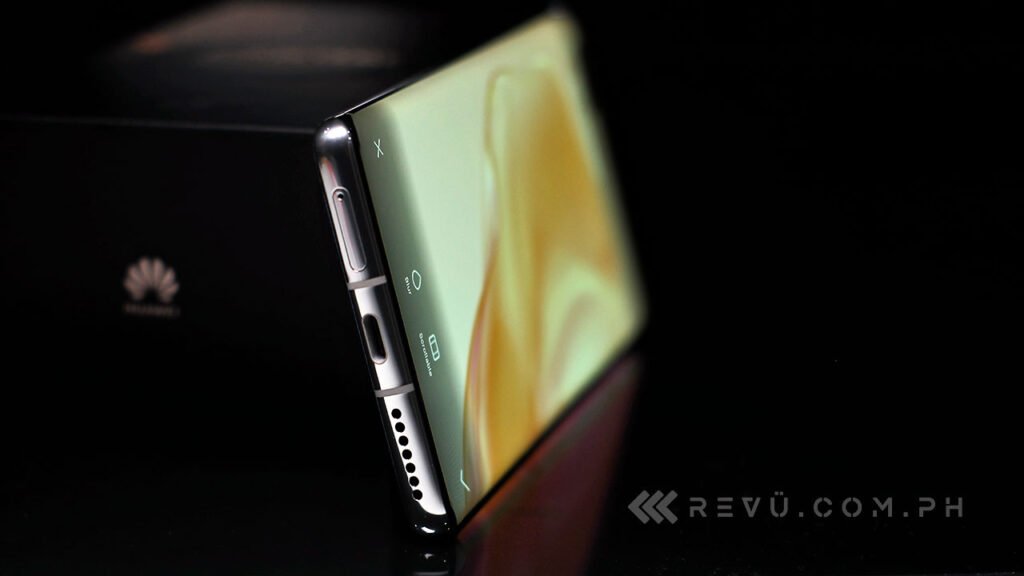
The Mate 40 Pro is the fastest-charging smartphone we’ve used so far
The Mate40 Pro, notably, is the fastest-charging smartphone we’ve used so far. Its wired charging rate goes up to 66 watts using the included wall adapter, while wireless charging maxes out at 50 watts. Super impressive. Meanwhile, the Galaxy Note 20 Ultra ships with a 25-watt power brick — still fast but not crazy-fast. To get better charging speeds on the Samsung, you must upgrade to a 45-watt charger.
It takes about 80 minutes to fully recharge the Note 20 Ultra from flat using a 25W adapter, while the Mate40 Pro just needs 50 minutes. Half an hour plugged will usually take you to 85% battery capacity.
Software-wise, the Mate40 Pro runs on Huawei’s latest EMUI 11 overlay with Huawei Mobile Services, while the Samsung Galaxy Note 20 Ultra comes with Android 10-based One UI 2.5 out of the box.
The bottom line is, as long as you don’t want to be dependent on GMS — and there are plenty of Android apps out there that don’t rely on it — you should be fine. Google services such as Gmail even work on the Mate40 Pro via Huawei’s native Email app or through the Gmail website using the Huawei Browser. There’s also the Huawei MeeTime app, which is a video-call application that enables crisp, high-quality calls on the smartphone. It’s perfect for catching up with friends and family during the holidays.
And the winner is?
The Huawei Mate40 Pro and Samsung Galaxy Note 20 Ultra are fantastic flagships that deliver where it matters, and their pros outweigh the cons. However, if we were to choose one over the other, we’d pick the Mate40 Pro, largely because of its aesthetics, superior camera system, powerful Kirin 9000 chipset with 5G, and much faster wired and wireless charging.
The Note 20 Ultra might be a better choice if you’re after the best-integrated stylus experience for productivity among smartphones and you absolutely need Google apps and services at your fingertips.
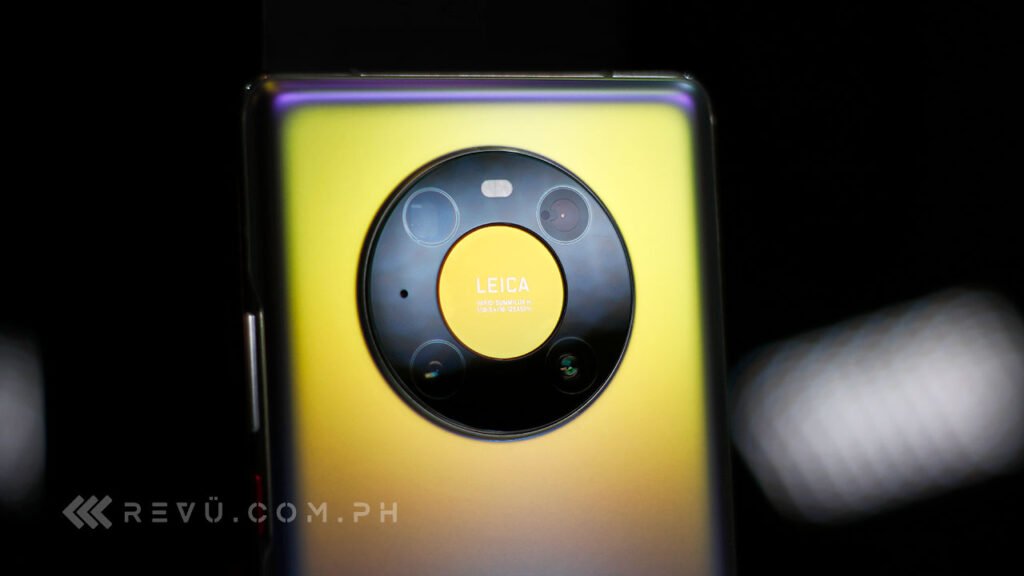
Our pick
But, as we’ve mentioned earlier, there are plenty of worthy alternatives around. Plus, you can use the Huawei M-Pen to doodle or write on the Mate40 Pro’s screen as you would on the Note 20 Ultra. So if you’re not getting the Samsung for creative work, you’ll probably be fine with a not-so-fancy stylus.
Then there’s the price tag to consider. In the Philippines, the Huawei Mate40 Pro is priced at P55,999 (around $1,165), while the Samsung Galaxy Note 20 Ultra is P67,990 ($1,414). That’s a pretty huge difference between two phones that both look and feel at the top of their class and perform on par with expectations at least. Provided you can live with its shortcomings, the Mate40 Pro wins this comparison.
To summarize:
- Hardware: Huawei Mate40 Pro
- Screen: It’s a tie. Should have been the Samsung Galaxy Note 20 Ultra; it has a sharper screen, but unfortunately, it maxes out at 60Hz while displaying 2K content.
- Camera: Huawei Mate40 Pro
- Performance: Huawei Mate40 Pro
Scores: 4: Huawei and 1: Samsung.
Video you may want to watch: The Mate40 Pro for vlogging
Disclosure: This comparison was commissioned by Huawei.
Share this Post

